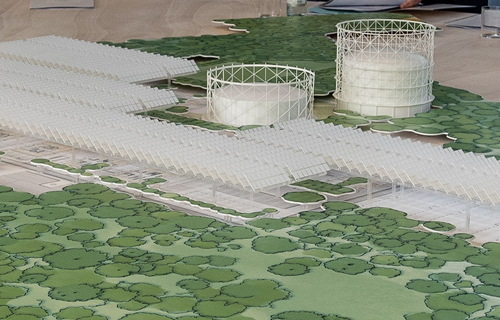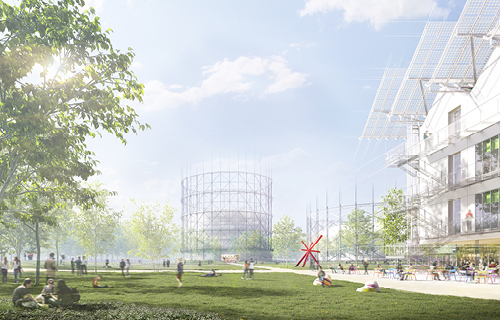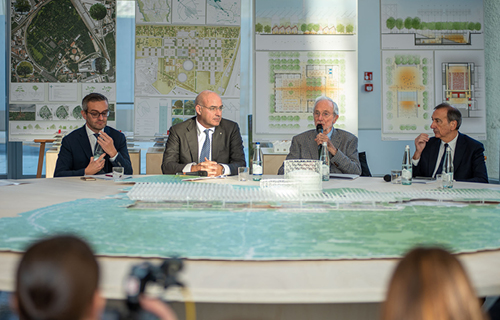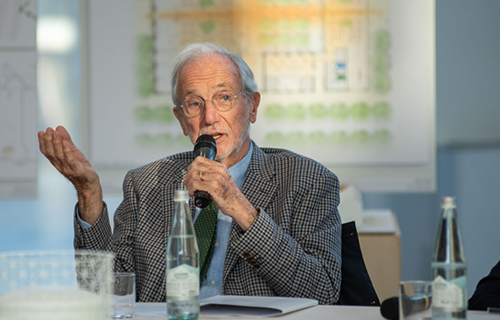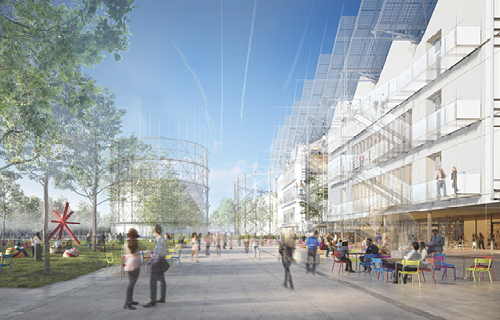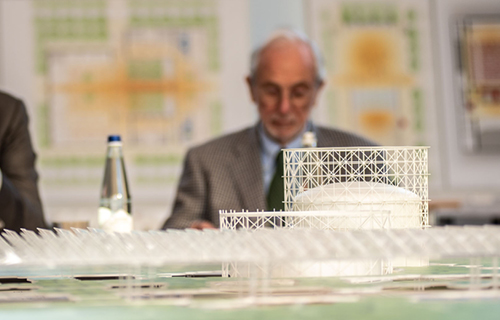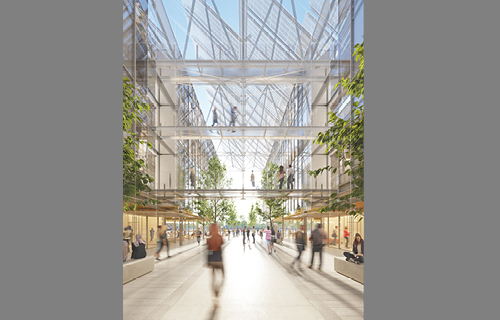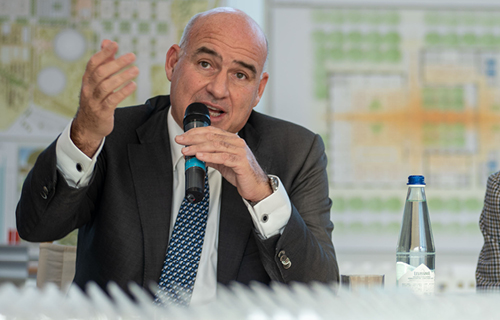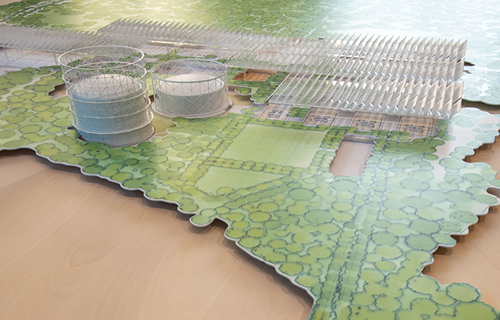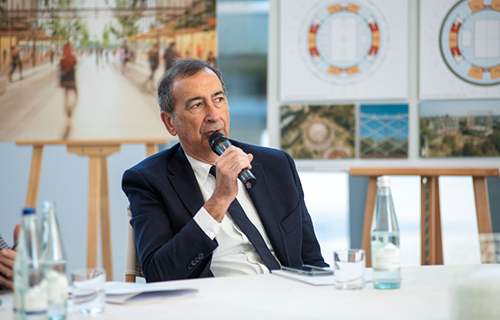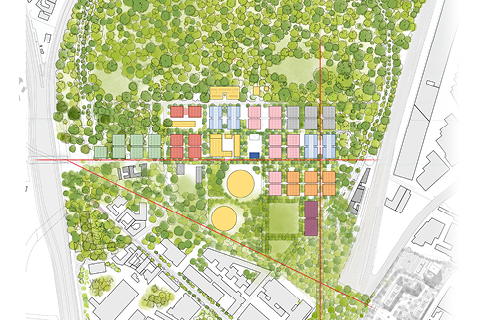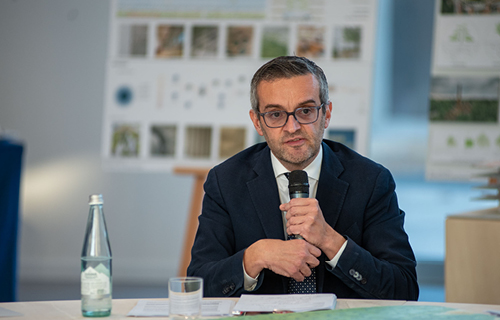Renzo Piano presents the Bovisa-Goccia Masterplan
A project aiming to connect Goccia to the city and the surrounding region
“Open, green and transparent”.Renzo Piano has presented the Bovisa-Goccia Masterplan in a meeting at Politecnico di Milano. In attendance were the Rector of the Politecnico Ferruccio Resta, the Councillor for Metropolitan City Development, Youth and Communication of Regione Lombardia, Stefano Bolognini and the Mayor of the city of Milan Giuseppe Sala.
The project in question covers a total surface area of 32 hectares, part owned by the Municipality of Milan (23.4 hectares) and part by Politecnico di Milano (9.1 hectares). The idea is to expand the campus, creating a science park/innovation hub and areas set aside for services to students, businesses and citizens. Works will get under way in late 2023, and be completed in 2026.
The project by RPBW studio with Renzo Piano was made possible by a major donation from the ION Foundation to the Politecnico di Milano.
The project follows on from and completes that planned by the Politecnico for the gasometer area, aiming to connect Goccia to the city and the surrounding region through mobility initiatives. This project, the subject of the recent memorandum of understanding signed by the Ministry for Sustainable Infrastructure and mobility, Ministry for Universitiy and Research, Lombardy Region, Municipality of Milan, Politecnico di Milano, FNM and Rete Ferroviaria Italiana, is about to enter the building phase.
Works include the construction of twenty new 4-storey buildings, rising to a height of 16 metres, covering an area of about 105,000 sq.m, plus the Scuole Civiche, connected by tree-lined pedestrian pathways and offering a variety of facilities that will make it a lively place to be. A large cycle-pedestrian path to the south, winding through the gasometers and the Lambruschini campus, will link up the 2 stations Bovisa and Villapizzone, which will be refurbished and interconnected to the whole Campus.
In addition to the Politecnico’s classrooms and labs, there will be student residence halls, and an area dedicated to startup, conforming to the highest international standards regarding links between the university and the business world: 35,000 sq.m of space set aside for deep tech innovation and the challenges of digital evolution and sustainability. The aim is to create a campus that is accessible, open to the city and primed for the exchange of ideas and functions.
Buildings will be erected on land located between the gasometers and the large power station, structures that are an example of industrial archaeology as well as an unmovable boundary, on the other side of which 24 hectares of woodland will be preserved, developed and opened up to citizens. Buildings will cover the same surface area as that previously occupied by the factories. In their place will be “white factories”, places of knowledge and know-how that respect local traditions and history.
The project, that also seeks to attain energy independence and eliminate CO2 emissions, involves the construction of 3 buildings for classrooms, 5 buildings for startups, one underground hall for conferences, 2 residence halls for about 500 students and the revamping of an old industrial building offering catering services to Campus guests.
Large trees will be planted and grow around the new buildings to create a connective tissue. The ground floors of campus buildings will be completely transparent, so that users can be able to enjoy an immersive experience in nature.
Renzo Piano explains:
The essence of the project was already etched into the place.
The idea was already there; it was just a question of time before it hatched.
There is the woodland and its majestic trees.
Then there are traces of the factory on the ground, the old buildings that preserve the memory of these places and their DNA.
“Today is a special day for Politecnico di Milano. It is an important step in the history of our University”. – commented the Rector, Ferruccio Resta – “Working alongside Renzo Piano, we have shared an idea that is now taking shape within a broader urban design. It is the fruit of an understanding between the public and the private sectors. This flagship project represents a new way of interpreting university life and the city of Milan in the future, meeting major urban, technological and social challenges. It will be a laboratory, a place for exchanging ideas and for innovation, for the city and for youngsters, working to attain the critical mass that is vital for competing internationally.”
"Regione Lombardia, – says Stefano Bolognini, Councillor for Metropolitan City Development, Youth and Communication of Regione Lombardia – "fully and strongly supports the Politecnico di Milano in this innovative and cutting-edge development and regeneration project. I am certain that, also thanks to the 55 million € of total investment by the Region, the whole area of the Bovisa district involved in the renovation works will be able to become a model throughout Italy, combining research, innovation, sustainability and new living spaces for the students who, in increasing numbers, want and will want to come to study at the Politecnico. Lastly, I would like to emphasize the institutional collaboration that has made it possible to achieve a result of extraordinary importance not only for Milan and Lombardy, but for the entire country, succeeding in synthesizing to realize an exceptional project for the University, for businesses and for the city."
“The plan to develop the Bovisa-Goccia area presented today perfectly represents the policies being pursued by our administration: development of the local district based on the 15-minute city concept, focus on the environment, collaboration with the university in the sphere of research and innovation and new residence halls for students, in their role as protagonists of change. These are all priority goals and actions in our agenda” – commented Giuseppe Sala, Mayor of Milan –. I wish to thank Renzo Piano and the Politecnico for giving, through this urban project, concrete form to the vision and idea of the city we want to create for the future".
Technical details of the Bovisa-Goccia Masterplan
- The layout is a system of orthogonal pathways arranged around the main pedestrian pathway, to the north of the gasometers.
- Vehicle access is kept to a minimum, and rendered secondary;
- There will be 20 new 4-storey, 16-metre-tall buildings, covering an area of approximately 105,000 sq.m.
- The connections between buildings and multiple functions will make this a lively district all around the clock.
- 24 hectares of woodland containing no roads or buildings.
- 2 stations, Bovisa and Villapizzone, will be revamped and interconnected to the whole Campus, providing public transport.
- At street level all buildings of the Campus Nord will be “open” and transparent.
- The Zero energy campus will be energy-independent and Zero Carbon, i.e. no C02 air emissions during its operation.
- All campus buildings will be built mostly with wood. Trees planted in the campus will restore, within thirty years, the amount of wood that will be used to construct the buildings.


